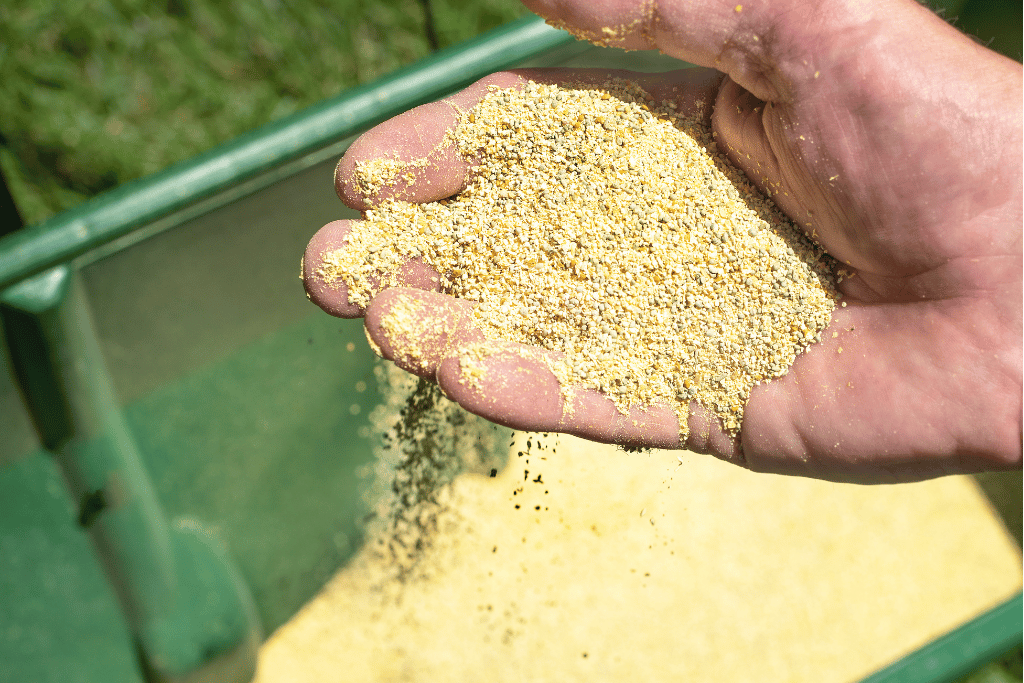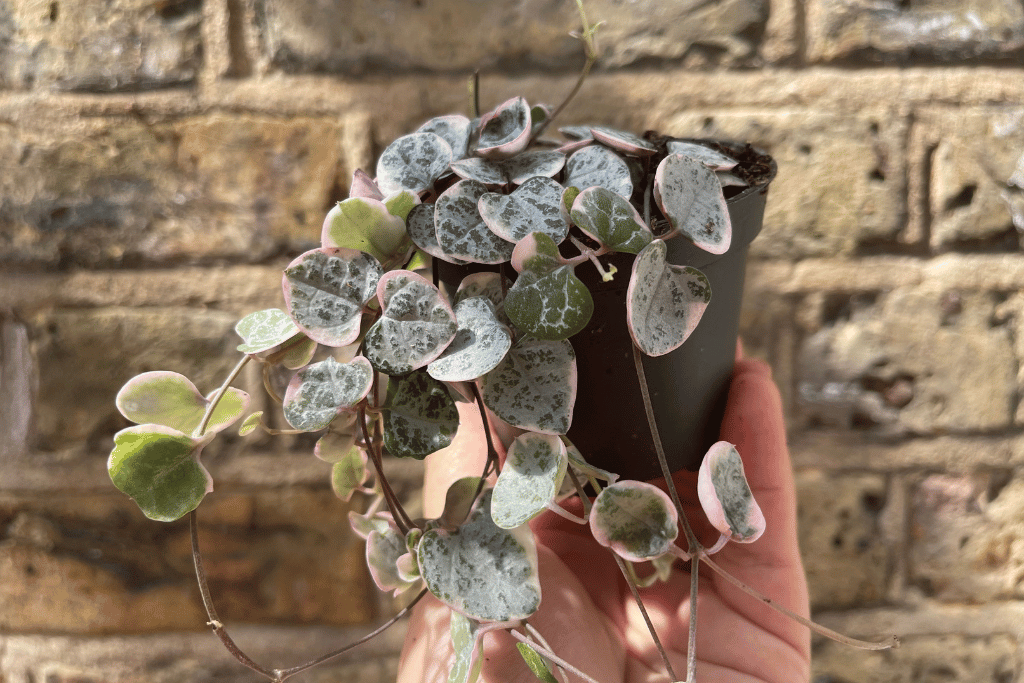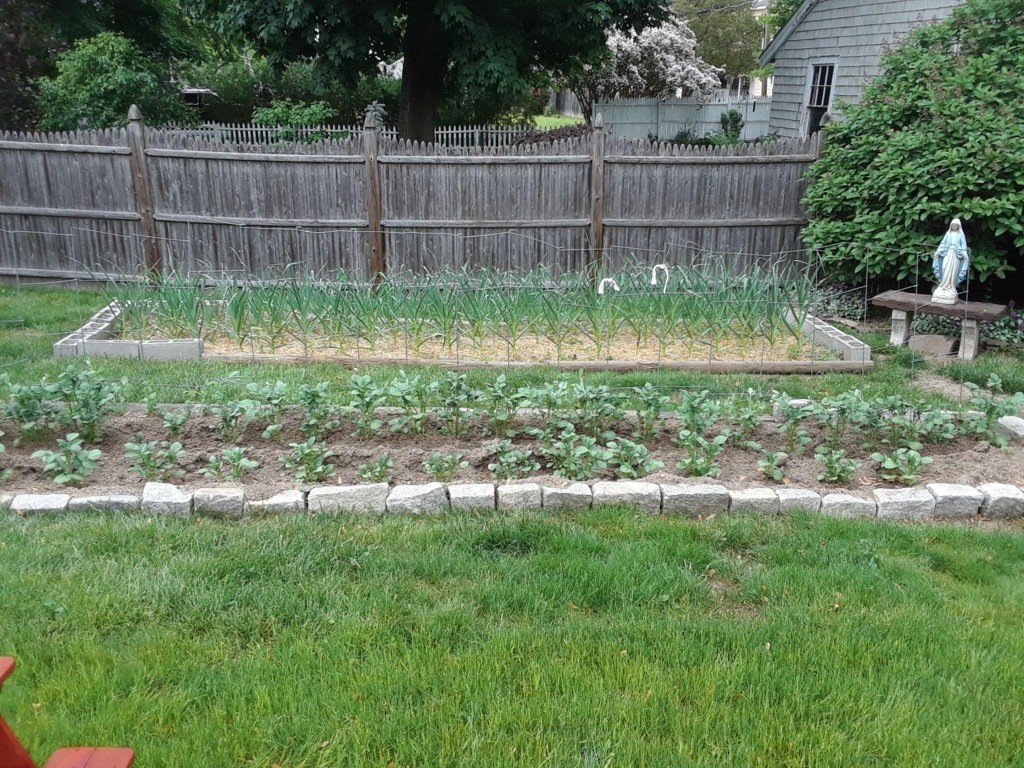
The first farm I ever worked on was in northern California. My friends and I were young and ambitious, with plans to grow obscene amounts of vegetables and fruits.
There was only one problem. The native soil was terrible. Perhaps it had been depleted and used up throughout past seasons, or possibly it was the natural state of the terrain in the desert-like climate. Whatever the case, we blew out a small motor tiller just trying to dig down 6” into the packed, hardpan soil. I was amazed, taken aback, discouraged, but not defeated. Where there is a will, there is a way.
There was no way we were going to grow our vegetables conventionally in field rows having to deal with that rock solid soil. We pivoted to the idea of constructing our own raised beds and filling them with bulk soil from the local farm & feed store.
This new project gave us a jolt of excitement and we went about collecting materials and ordering a few yards of soil. We purchased 2×4 and 4×4 lumber and gave it all a couple coatings of linseed as a sealant. This would prevent the wood from rotting in the ground, protecting our investment for the long term. We stacked the 2x4s on top of one another and cut down the 4x4s to use as corner posts.
By the time the soil delivery arrived we were so proud and confident in our raised beds. The beds were filled with quality soil, our seedlings were transplanted and we went on to have an exceedingly productive season.
Because of that positive impression, every garden I have established since has utilized raised beds for growing everything from tomatoes and peppers to garlic and potatoes. Raised beds, in my opinion, are indispensable in the home garden.
Why Build Your Own Raised Beds?
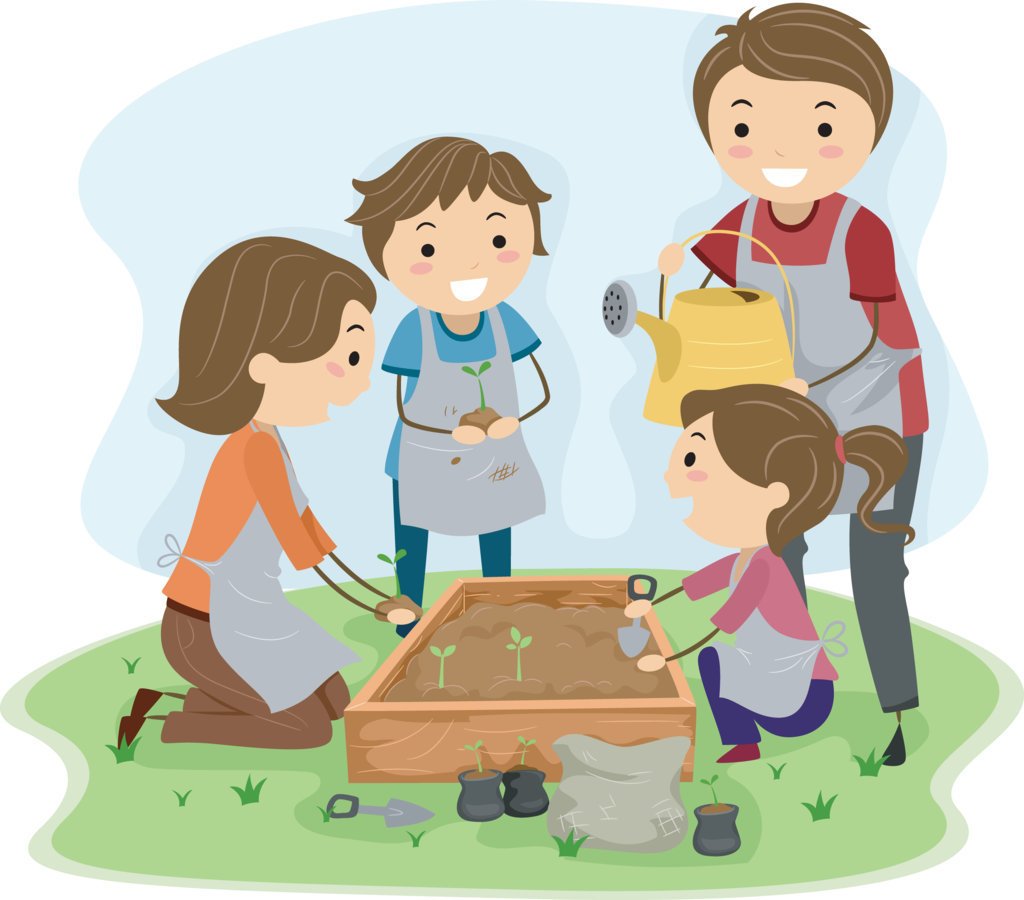
Growing in raised beds is superior to planting directly into the ground for many reasons. Let me list out exactly why:
- You have control over the input of good quality soil and compost.
- The loose soil won’t require tilling, encouraging root growth and the development of a healthy microbiome.
- Raised beds provide better drainage and water retention.
- Weeds are less prevalent and easier to manage.
- Raised beds are easier to work in because they are up off the ground.
- The soil warms earlier in the spring and stays warmer through the fall.
- They can be easier to enclose and fence off to protect from wildlife.
- Raised beds maximize space where it is limited.
A List of Inexpensive Ideas for DIY Raised Beds
There are so many different materials and methods to explore when designing your own raised beds. Chances are at least one of these options will work in your garden space:
- Concrete blocks
- Galvanized steel bins
- Corrugated metal
- Lumber from the hardware store
- Recycled materials
- Wood pallets
- Prefabricated kit from big box store
Build a Raised Bed with Concrete Blocks
Concrete blocks are an excellent choice when planning for a long term garden. They will last just about forever, giving you peace of mind that once you build it, your job is done. They are readily available at any home improvement store, and quite cheap at that.
Each block will cost about $2 and typically measure 8” tall and 16” long. At that rate you can easily build a good sized bed for under $40. It’s a relatively cheap investment for a bed that you’ll see produce pounds and pounds of fresh produce over the years.
It will be important to first lay out the shape and design of your raised bed, because cement blocks are heavy!
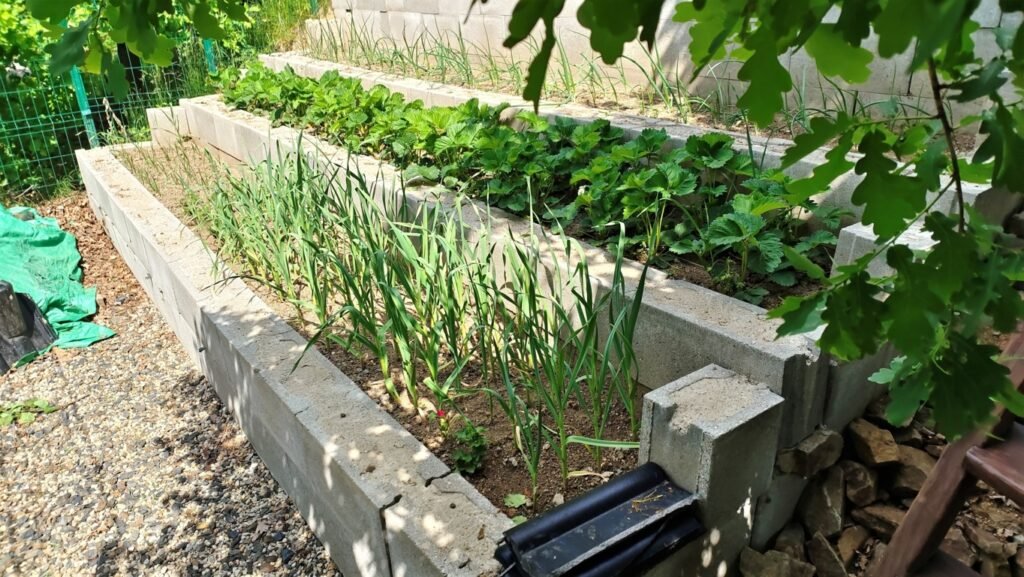
You’ll want to move them as little as possible once they’re in place. Use a measuring tape to make sure the blocks are even and straight. Remove any debris from the area and level the ground so that all the blocks fit nicely together. Once they’re all laid in place, the bed can be filled with soil and planted out!
Bricks are much smaller but can be used in the same fashion. Stacked on top of each other, the bed can be customized into any shape and will fit any space of the garden. Bricks also retain heat well, helping keep the soil warmer early and late in the season.
I made a few raised beds some years back using concrete blocks. It was quite a bit of grunt work, lugging them from the store, into the car and then into my backyard. Next came some measuring, leveling and finally setting in place. The whole process took a day’s work, but turned out to be inexpensive, a good workout and totally worth it in the long run, given the production these beds have provided over the years.
Use Galvanized Steel Bins as a Raised Bed
Galvanized steel bins have become popular options as best raised garden beds. They can be easily found online or at local home improvement stores at reasonable prices. Galvanized steel is relatively lightweight making them a good option for temporary spaces. The material is extremely durable and will last a long time due to the zinc coating that protects it from corrosion.
Galvanized steel bins usually have an open bottom, but may also come with drainage holes. This helps any excess water find its way out of the soil instead of keeping it too soaked. The bins are available in various heights, which is something to consider based on your abilities and needs. Think about what length and width best accommodates your space and buy accordingly.
There are endless options to choose from, and these durable, lightweight containers won’t disappoint.
Corrugated Metal Raised Beds
Corrugated metal is another go to material for garden bed construction because of its availability, versatility and overall sturdiness. Full sheets, which cost about $15, measure 8’ long and 25” wide. Smaller pieces are available too if you can’t cut your own, even online.
Using corrugated metal for your raised beds isn’t too difficult, but does require a DIY attitude and some carpentry skills. There are a variety of designs and structures that can be built, most using standard 2x4s for the frame and 4x4s as corner posts.
Altogether, beds made of corrugated metal are attractive, effective, solid and will last a long time. Corrugated metal is an excellent choice to build your beds, especially if you’re a handy gardener.
Source Quality Lumber for Your Raised Beds
Good old fashioned pieces of lumber will certainly get the job done if you’re looking for a cheap and simple construction project. All different sizes and lengths of wood cuts can be found at the home improvement store.
Opt for lumber that isn’t pressure treated. The chemicals used in this process can leach into the soil, contaminating the food you and your family will be consuming. Pressure treated wood lasts longer, but isn’t worth the risk. Instead, apply a coating of raw linseed oil to your lumber as a waterproofing that will extend its lifespan.

Choose a garden site that is level and will accommodate the size garden bed you’re going to build. Basic beds can be constructed with little effort and skills. Use 2×4 or 2×8 boards as the frame and screw them into 4×4 corner posts. The 4×4 posts can be cut to the desired height of your bed with the frame boards stacked on top of each other until the bed is complete.
Corner posts don’t necessarily need to be driven into the ground, just place them on top of the soil and everything will settle and stay in place once the bed is filled with soil. Beds made of pure wood are affordable, easy to build and have a natural look, very aesthetically pleasing.
Raised Beds Made From Recycled Materials
Free might be the most beautiful word in the English language, especially to a stingy gardener! There are a whole slew of materials frequently thrown away that could be repurposed into your next raised garden bed.
Depending on where you live, you may have rocky, even stoney soil. This past year I pulled enough stones out of a newly tilled garden plot to make a nice natural border around a few beds. There’s no better way to use these large rocks than to put them to work for you.
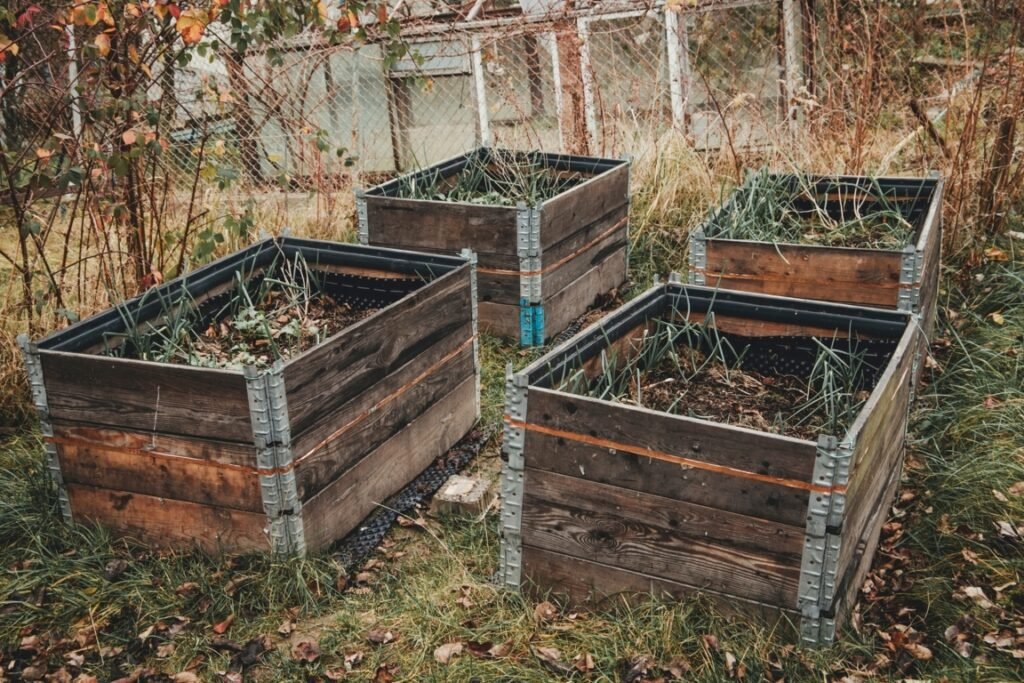
Landscaping timber or railroad ties are often available at a local dump. They’re long, unwieldy and cumbersome, but make great borders for those same reasons. As long as they are old and worn out they should be safe to use in the garden.
Other naturally sourced materials are often quite effective. Lumber from fallen trees can be foraged from the forest and will make a nice bed while naturally decomposing, adding organic matter to your soil. Hay bales work great as well. They can be positioned into a bed shape, filled with soil and planted out. They too will decompose, adding nutrients to your bed. Hay bales will only last for a few years before they need to be replaced.
Wood Pallets Are a Versatile Option for Your Raised Bed
Pallets can often be found on the cheap, or for free in many cases. It’s important to be aware that pallets are used industrially and often painted or pressure treated with chemicals. Only use those that look clean and have a natural finish.
Pallets can be broken down, using their planks to construct a bed. Creative growers have fashioned them into above ground planters and living walls. There are a lot of different directions an imaginative gardener can go with soil, seeds and a few handy wood pallets.
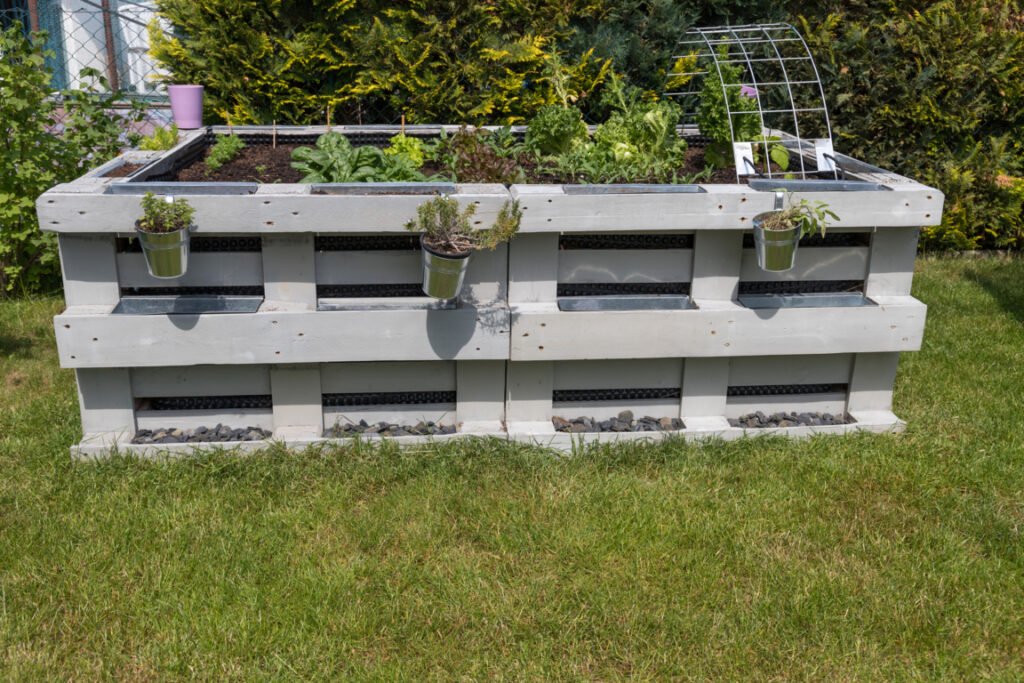
Use a Store Bought Kit to Build Your Raised Bed
Prefabricated kits are commonly found at garden centers and home improvement stores. They are often easy to put together and have a nice sleek look. The kits that have legs, lifting the bed a few feet off the ground, are especially useful for gardeners with mobility issues. There are a lot of convenient advantages to purchasing a premade store kit.
For all of their pros, they do have a few cons as well. For me, I just can’t shake the feeling that these kits are a bit like Ikea furniture. It’s not the best quality, but you slap it together and it gets the job done. They lack character and natural charm.
Kits will usually be more expensive and less satisfying than building your own raised bed. Also, be aware of what materials are used in the product. Certain plastics can leach into your soil and lead to drainage problems.
Be Creative and Have Fun Building Your Own Raised Garden Beds!
Remember, this is your own personalized garden space and there are no limits to what you can create. These are all just suggestions intended to spark ideas and inspire action. As you have read, many materials can be used to build a raised bed that accommodates any size garden space.
And if you’re like I was, faced with soil that is rock hard, or you just want easier maintenance and more production from your garden, raised beds, of any dimension, design or material, are well worth your time and effort!
We encourage you to explore the site for more educational and inspirational ideas to implement in your own garden. Happy growing!
Frequently Asked Questions (FAQ)
What is the cheapest option for making my own raised beds?
Above we list many cheap options for building your own raised garden bed. The cheapest route will most certainly be by recycling or salvaging free materials. Gardeners are typically frugal by nature and accustomed to upcycling tools and other supplies. Don’t hesitate to utilize what nature offers, like fallen logs or stones. Neighbors, town dumps and junkyards are often good sources of free building material.
Should I buy a raised bed kit or build my own?
Raised bed kits are usually more expensive than building your own. That said, they are convenient and reliable. It depends how comfortable you are constructing your own and how much you’re looking to spend. I always like to make my own for the feeling of accomplishment, and nothing can replace the personalized look and feel.
How deep should my raised bed be?
Raised beds should be at least 8” deep, but deeper is better. Most plant root systems need at least 6-8” of loose soil to thrive. The ground below the raised bed can be tilled or turned over before installation to give roots extra space to grow down deep.
What kind of soil should I use to fill my raised bed?
It’s a good idea to fill your bed with a high quality soil mixed with compost and other organic material. Starting with a rich, fertile foundation will ensure that your raised beds will nourish your crops for years to come.


